His Majesty King Bhumibol Adulyadej The Great
Chapter 3: His Majesty King Bhumibol Adulyadej the Great (Rama IX),
Her Majesty Queen Sirikit The Queen Mother,
Their Royal Highnesses the Princesses and the Princes

His Majesty King Bhumibol Adulyadej the Great
King Rama IX was born abroad, as at that time His Royal Highness Prince Mahidol Adulyadej, the Prince Father, was pursuing medical studies at Harvard University. After completing his studies, he returned to Thailand in 1928. However, he passed away on 24 September 1929, when King Rama IX was only two years old.
Education
When King Rama IX reached the age of five, in 1932, he began his primary education at Mater Dei School on Ploenchit Road, Bangkok. That year also marked the transformation of Thailand’s political system from absolute monarchy to constitutional monarchy, during a time of considerable national unrest. Concerned for the future of her children’s education under the new system, Her Royal Highness Princess Srinagarindra, the Princess Mother, wished that her sons and daughter receive a modern education. With the gracious permission of King Prajadhipok (Rama VII), she took her three children to reside in Lausanne, Switzerland, in early 1933.
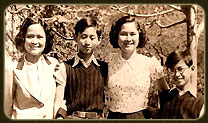
Photographs of His Majesty’s Childhood in Lausanne, Switzerland
King Rama IX began his primary education at Mirmont School and also received private tutoring in several essential foreign languages, including French, German, and English, at the royal residence after returning from school. His tutors admired his intelligence and quick understanding of lessons. As he grew older, His Majesty developed strong interests in other fields such as handicrafts, mechanics, agriculture, and the arts, particularly music. He displayed remarkable talent both in playing musical instruments and in composing songs, earning recognition as a gifted and versatile individual. These diverse academic and artistic interests later became invaluable foundations for the development projects he initiated for the country.
For his secondary education, King Rama IX attended the Ecole Nouvelle de la Suisse Romande in Chailly-sur-Lausanne. He later obtained the Bachelier des Lettres diploma from the Gymnase Classique Cantonal in Lausanne and pursued higher education at the University of Lausanne, where he chose to study Science in the field of Engineering.
In 1934, his elder brother, His Royal Highness Prince Ananda Mahidol, ascended the throne as King Ananda Mahidol (Rama VIII) of the Chakri Dynasty. Consequently, in 1935, His Royal Highness Prince Bhumibol Adulyadej was elevated to the rank of “Somdet Phra Chao Nong Ya Ther Chaofa Bhumibol Adulyadej” (His Royal Highness Prince Bhumibol Adulyadej, the Younger Brother of the King).
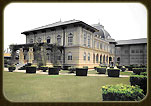
Boromphiman Throne Hall
In 1938, His Royal Highness accompanied King Ananda Mahidol on his first return to Thailand. During this visit, they resided temporarily at Chitralada Villa in Dusit Palace before returning once again to Switzerland. Later, in 1945, he accompanied King Ananda Mahidol on a second return to Thailand, during which they took residence at the Boromphiman Throne Hall in the Grand Palace.
Ascended the Throne
On 9 June 1946, King Ananda Mahidol passed away suddenly. With the approval of the government, the Parliament, the royal family, and state officials, they paid their respects to Her Majesty the Queen Mother at the Boromphiman Throne Hall in the Grand Palace and formally invited His Royal Highness Prince Bhumibol Adulyadej, who was then 19 years old, to ascend the throne. He became the ninth monarch of the Chakri Dynasty and inherited the royal lineage directly from King Chulalongkorn (Rama V).
As the Head of State with responsibilities for governing the nation, King Rama IX subsequently returned to Switzerland in 1946 to continue his studies in disciplines essential for administration and governance, namely Law and Political Science, at the University of Lausanne.
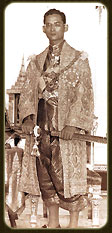
Royal Coronation and Marriage Ceremony
While studying abroad, His Majesty King Rama IX met Mom Rajawongse Sirikit Kitiyakara, daughter of Mom Chao Nakkhatra Mangkala Kitiyakara and Mom Luang Bua Kitiyakara, and they became mutually fond of each other.
In 1949, King Rama IX was involved in a car accident in Switzerland and had to receive medical care. He graciously requested Mom Luang Bua Kitiyakara to bring her two daughters, Mom Rajawongse Sirikit and Mom Rajawongse Busba, to visit and attend to His Majesty’s health. Following his recovery and return to the royal residence, Her Royal Highness Princess Srinagarindra requested that Mom Rajawongse Sirikit continue her studies in Lausanne at a prestigious girls’ school that offered special instruction in languages, arts, music, and history. Subsequently, His Majesty became engaged to Mom Rajawongse Sirikit Kitiyakara on 19 July 1949 in Lausanne, Switzerland.
In 1950, upon returning to Bangkok, His Majesty resided at Amphorn Sathan Throne Hall, Dusit Palace. He graciously ordered the organization of the royal cremation ceremony for His late brother, King Ananda Mahidol (Rama VIII), in March 1950.
Later, on 28 April 1950, His Majesty graciously presided over the Royal Coronation and Marriage Ceremony with Mom Rajawongse Sirikit Kitiyakara at the Srapathum Palace of Her Majesty Queen Sri Savarindira, the Queen Grandmother.

He received the Royal Conch from Her Majesty Queen Sri Savarindira, the Queen Grandmother, at Srapathum Palace.
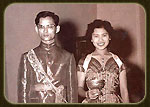
His Majesty King Bhumibol Adulyadej and Mom Rajawongse Sirikit Kitiyakara
The Coronation of His Majesty the King
On 4–5 May 1950, His Majesty graciously presided over the Royal Coronation Ceremony according to ancient royal traditions at Phitsanulok Hall in the Grand Palace. His full royal title, as inscribed in the Golden Book, was proclaimed: “His Majesty King Bhumibol Adulyadej the Great, of the Chakri Dynasty, Sovereign of Siam.” During the ceremony, His Majesty delivered the First Royal Command, stating: “I shall reign the kingdom with righteousness, for the benefit and happiness of the Thai people.” He then poured sacred water (Takshina Thotok) and took the royal oath to govern the kingdom according to the Ten Royal Virtues. On this occasion, His Majesty also graciously elevated Mom Rajawongse Sirikit Kitiyakara to Her Majesty Queen Sirikit, the Queen of Thailand.
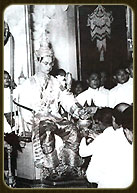
Royal Buddhist Ordination Ceremony
His Majesty King Bhumibol Adulyadej (Rama IX), as the Supreme Patron of Buddhism, held a profound devotion to Buddhism and to royal traditions. He recognized Buddhism as the national religion, cherished by the majority of his people. As he became more familiar with the principles and practices of Buddhism while fulfilling his royal duties, His Majesty’s faith deepened further. He came to realize that the teachings of the Lord Buddha are founded on reason and truth, and that even when examined from a scientific perspective, they remain enduringly respected and trusted.

In 1956, Somdet Phra Vajirayan, the Supreme Patriarch of Wat Bowonniwet Vihara (Mom Rajawongse Chuen Nobwong, Dharma name: Sujitto, holder of Grade 7), whom His Majesty greatly respected and held in close personal esteem for his many contributions, fell gravely ill. His condition caused widespread concern, and there appeared to be little hope for recovery. By fortunate circumstance, he recovered miraculously. Consequently, King Rama IX resolved that, if he were to undergo the Royal Buddhist Ordination with the Supreme Patriarch serving as his preceptor, it would be a most fitting opportunity to express his reverence and devotion to the Supreme Patriarch personally.
In addition, His Majesty, full of virtue and filial devotion, wished to repay the great kindness of His Royal Father and His Royal Mother. He therefore resolved to undergo the Royal Buddhist Ordination at Wat Phra Si Rattana Satsadaram (the Temple of the Emerald Buddha) in the Grand Palace, dedicating the merit to honoring their beneficence. From 22 October to 5 November 1956, for a period of 15 days, he was conferred the monastic title “Phumiphon Bhikkhu” and resided at Pan Ya Residence, Wat Bowonniwet Vihara. During this time, a royal command was issued appointing Her Majesty Queen Sirikit as the Regent of the Kingdom in his absence.
While ordained as a monk, His Majesty practiced the monastic discipline like any novice monk, diligently studying the Buddhist scriptures and strictly observing the Vinaya.
Her Majesty Queen Sirikit, The Queen of Thailand
Her Majesty Queen Sirikit, The Queen of Thailand, is the eldest daughter of General Prince Nakkhatra Mangkala Kitiyakara (formerly Mom Chao Nakkhatra Mangkala Kitiyakara) and Mom Luang Bua Kitiyakara (née Sanitwong). King Prajadhipok (Rama VII) bestowed upon her the name “Sirikit,” which means “the glory of the Kitiyakara family.”

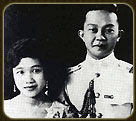
Colonel Mom Chao Nakkhattra Mongkol and Mom Luang Bua (Sanitwong) Kitiyakara (titles at that time)
Her Majesty Queen Sirikit was born on Friday, 12 August 1932, at the residence on Rama VI Road, Bangkok, of General Chaophraya Wongsanupraphan, the father of Mom Luang Bua Kitiyakara. At that time, Mom Chao Nakkhatra Mangkala Kitiyakara, her father, held the rank of Colonel and served as Assistant Chief of Staff of the Royal Thai Army, which was the sole position of its kind at the time.
Following the transition from an absolute monarchy to a constitutional monarchy, Mom Chao Nakkhattra Kitiyakara resigned from military service and was appointed by the government as First Secretary at the Royal Thai Embassy in Washington, D.C., United States of America.
Mom Luang Bua Kitiyakara remained in Thailand. After giving birth to Mom Rajawongse Sirikit Kitiyakara, she traveled to join her husband, leaving their young daughter under the care of General Chaophraya Wongsanupraphan and Mrs. Wanida Picharini, her paternal grandparents.
In 1934, Mom Chao Nakkhattra Kitiyakara resigned from his government post and returned to Thailand with his family. He brought back his second son, Mom Rajawongse Adulyakit Kitiyakara, who had been entrusted to Mom Chao Apornsaman (Thevakul) Kitiyakara, and Mom Rajawongse Sirikit Kitiyakara, who had been staying with her paternal grandparents, to live together at the family residence on Krung Kasem Road, Thewes, Bangkok.
Her Majesty Queen Sirikit received her early education in the kindergarten section of Rajini School. She then attended St. Francis Xavier Convent School for her primary and secondary studies, during which time she also studied piano. At the age of 14, upon completing the third year of secondary school, she left the school as her father, Mom Chao Nakkhatra Kitiyakara, was appointed Ambassador to the Court of St. James in the United Kingdom.
During this period, Her Majesty focused on studying languages and music, particularly the piano, with a determined intention to gain admission to a prestigious music university in Paris.

Her Majesty Queen Sirikit, The Queen of Thailand (Mom Rajawongse Sirikit Kitiyakara)
Mom Chao Nakkhattra Kitiyakara served as ambassador to several countries. By 1948, while stationed in Paris, France, he and his family had the honor of receiving His Majesty King Bhumibol Adulyadej on several occasions whenever the King had official duties in Paris. This allowed the family to attend to His Majesty and provide assistance each time, becoming well-acquainted with the royal presence.
Subsequently, His Majesty graciously invited Mom Chao Nakkhattra Kitiyakara and his family to a private audience. Queen Mother Srinagarindra requested that Mom Rajawongse Sirikit Kitiyakara be betrothed to the King. A private engagement ceremony was held on 19 July 1949, during which the engagement ring previously given by Prince Mahidol Adulyadej to Queen Mother Srinagarindra was used as the betrothal ring.
In 1950, when His Majesty King Bhumibol Adulyadej returned to Bangkok, he graciously presided over the royal cremation of His Majesty King Ananda Mahidol (Rama VIII) in March 1950. Later, on 28 April 1950, His Majesty graciously presided over his Royal Wedding Ceremony with Mom Rajawongse Sirikit Kitiyakara at Srapathum Palace, the residence of Her Majesty Queen Sri Savarindira, the Queen Grandmother. During the ceremony, Her Majesty Queen Sirikit received the Royal Conch from the Queen Grandmother.

She received the Royal Conch from Her Majesty Queen Sri Savarindira, the Queen Grandmother.
On 5 May 1950, His Majesty graciously presided over the Royal Coronation Ceremony, following the ancient royal traditions, at Phra Thinang Paisan Thaksin in the Grand Palace. On this occasion, Her Majesty Mom Rajawongse Sirikit Kitiyakara was elevated to the rank of Queen, receiving the title “Her Majesty Queen Sirikit.” During the ceremony, she received the Royal Conch, was anointed, and was bestowed with royal decorations, including the auspicious Order of the Nine Gems (Mongkol Naparat Ratchaworaphon).
During the Royal Wedding Ceremony, a Royal Command was graciously issued to elevate Mom Rajawongse Sirikit Kitiyakara to Her Majesty Queen Sirikit.

In 1956, when His Majesty King Bhumibol Adulyadej entered the monkhood for a period of 15 days (from 22 October to 5 November), a Royal Command was graciously issued appointing Her Majesty Queen Sirikit as Regent in his absence. During this period, Her Majesty dutifully carried out the royal responsibilities on behalf of the King with wisdom and efficiency. In recognition of her service, she was graciously conferred the title “Her Majesty Queen Sirikit, The Queen of Thailand.”

His/Her Royal Highnesses the Princes and Princesses


His Majesty King Bhumibol Adulyadej and Her Majesty Queen Sirikit have four children, comprising Their Royal Highnesses the Princes and Princesses:
1. After the Royal Coronation Ceremony, His Majesty the King traveled to Lausanne, Switzerland, to receive medical care as advised by his physicians. During his stay in Lausanne, Her Majesty Queen Sirikit gave birth to their first daughter, Her Royal Highness Princess Ubolratana Rajakanya Sirivadhana Barnavadi, at Montchoisi Hospital in Lausanne on Thursday, the 14th day of the waning moon in the 4th lunar month of the Year of the Rabbit, corresponding to 5 April 1951.

Her Royal Highness Princess Ubolratana Rajakanya Sirivadhana Barnavadi
When Their Royal Highness’s first daughter had reached the age of seven months, His Majesty the King returned to Bangkok and took residence at Chitralada Royal Villa, Dusit Palace.
Chitralada Royal Villa, built during the reign of His Majesty King Vajiravudh (Rama VI), is located within the Chitralada Gardens, part of Dusit Palace. The villa lies between Ratchawithi Road, Rama V Road, Si Ayutthaya Road, and Sawankhalok Road (to the east). It is a two-story brick-and-mortar building, adorned with intricate stucco designs. The interior features beautifully carved wooden panels as decorative elements.
The villa is situated to the north of Paruskavan Palace, which shares a similar architectural style. Subsequently, Their Majesties moved to reside at Amphon Sathan Throne Hall, Dusit Palace, as His Majesty graciously ordered renovations to Chitralada Royal Villa to serve as a residence, instead of the government constructing a new palace. It was at Amphon Sathan Throne Hall that Her Majesty Queen Sirikit gave birth to their three other children, comprising Their Royal Highnesses the Princes and Princesses

Chitralada Royal Villa
2. His Royal Highness Crown Prince Maha Vajiralongkorn was born on Monday, the 6th day of the waxing moon in the 9th lunar month of the Year of the Dragon, corresponding to 28 July 1952. He is the only son of His Majesty King Bhumibol Adulyadej and Her Majesty Queen Sirikit.
The Supreme Patriarch, Krom Luang Vajirananavongs, bestowed upon him the full royal name:
“Somdet Phra Chao Lukya Thoe Chao Fa Vajiralongkorn Borommarachadisorn Santatiwongse Thewesadhamrong Subariban Apikunupakara Mahitaladulyadej Bhumibol Naresuan Vorarangkura Kitisirisomboonsawangwat Boromma Khattiya Rajakumarn Kachanam”

On 28 December 1972, His Royal Highness was elevated and granted the title of Crown Prince of Thailand as follows:
His Royal Highness Crown Prince Maha Vajiralongkorn Bodindradebayavarangkun Sirikitsombun Sawanwat Warakattiya Rajasanthatiwong Mahitalapongso Dulyadej Chakri Naruebet Yuvapras Visutth, Crown Prince of Thailand.
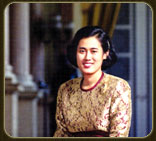
3. Her Royal Highness Princess Sirindhorn Thippharotnasuda Kitivannadulsobhak was born on Saturday, the 10th day of the waxing moon in the 5th lunar month of the Year of the Rooster, corresponding to 2 April 1955.
On 5 December 1977, Her Majesty graciously conferred upon her the title:
“Her Royal Highness Princess Maha Chakri Sirindhorn, Princess of Thailand, Rajasima Kunakorn Piyachart.”
4. Her Royal Highness Princess Chulabhorn Walailak, the Princess Royal, was born on Thursday, the 7th day of the waxing moon in the 8th lunar month of the Year of the Rooster, corresponding to 4 July 1957.
On 31 October 1957, after the completion of renovations at Chitralada Royal Villa, she moved from Amphon Sathan Throne Hall, Dusit Palace, back to reside at Chitralada Royal Villa, Dusit Palace, where she has remained to the present day.

In 1982, His Majesty King Bhumibol Adulyadej fell ill. On the advice of his physicians, he had to rest and was unable to carry out his royal duties as usual. Concerned that his initiated projects might be delayed, he graciously commanded Her Majesty Queen Sirikit to travel on his behalf to visit the people and hear about their joys and hardships in various provinces.
From a young age, Her Majesty the Queen had a deep love for nature and a strong bond with wildlife and forests. She was aware of the importance of the principle of coexistence between human life and the surrounding environment.
Through her visits to the rural communities, Her Majesty observed that the villagers faced serious water shortages. She realized that the problem largely stemmed from deforestation and the destruction of watersheds due to the villagers’ shifting cultivation practices—done out of necessity to earn a living. She understood that solutions had to be gradual, involving education about the harmful effects of such actions while simultaneously providing alternative occupations.
Furthermore, many people unknowingly cut down trees for construction, repair of homes, or for hire by entrepreneurs to sell timber abroad. Her Majesty remarked that educating the public on the value of forests and showing that forests belong to the people would help reduce illegal logging and forest destruction.
As a result, the “Forest for Water” project, initiated by Her Majesty Queen Sirikit, was established in Song Dao District, Sakon Nakhon Province. She personally planted trees at a demonstration site prepared for the villagers attending the ceremony, showing them the proper methods of tree planting. She assigned the villagers to care for the trees, provided each family with a monthly stipend of 1,500 baht, and leased abandoned land from the villagers to plant additional trees. The area expanded from the initial 1 rai to 142 rai.
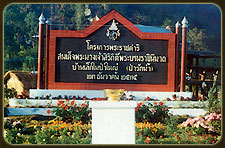
The “Small House in the Big Forest” Project (Forest for Water)
Her Majesty Queen Sirikit personally planted trees on her own land in Hat Sai Yai Subdistrict, Hua Hin District, Prachuap Khiri Khan Province, an area prone to drought. She selected fast-growing species such as Narong Acacia and Siamese Senna to test whether they could thrive there, with the aim of demonstrating that these trees could grow successfully throughout the country.
In addition, there are numerous other royal initiatives of Her Majesty Queen Sirikit, such as the Silapachip (Handicraft) Project, which has now flourished with members nationwide, and the Queen Sirikit Silk Project, among others.


She promoted the cultivation of mulberry trees, the rearing of silkworms, and the weaving of silk fabric.
Queen Sirikit Silk Project
Year Established: 1973 (B.E. 2516)
Objectives:
To produce silk cocoons for sale to silk-reeling factories, thereby promoting the availability of silk threads for weaving and supporting household-based silk industries.
To encourage interested villagers to gain experience in mulberry cultivation and silkworm rearing, enabling them to apply the knowledge in their local communities.
Background of the Queen Sirikit Silk Project
Queen Sirikit aimed to promote silk weaving as a household industry to preserve the traditional Thai craft among women, while also increasing family income through the sale of silk cloth and skirts. She graciously provided silk threads to villagers in various regions for weaving and emphasized that encouraging mulberry cultivation and silkworm rearing would create additional employment opportunities. This would also reduce the need to import silk from abroad.
King Bhumibol Adulyadej supported the project from the outset by providing guidance on constructing reservoirs and water pipes to facilitate the work. The project was designed so that villagers could adopt and apply the methods in their own communities, complementing the official project activities that small villages might not be able to implement independently.
Project Location:
The project was established on land known as Nong Hiang in Hua Hin District, Prachuap Khiri Khan Province, approximately 6 kilometers from the district center. The total area is 300 rai, consisting of land donated by devoted supporters to the King and land purchased with the King’s personal funds.
Implementation Method:
Project development officers were sent to train in mulberry cultivation and silkworm rearing at research and training centers in Nakhon Ratchasima and Khon Kaen provinces.
Initially, the project included 6 families as members, who planted mulberries and raised silkworms under the supervision of the project officers.
The project later accepted outside members for training and practical experience, enabling them to apply the knowledge in developing their own local communities.
Project Implementation
1972 (B.E. 2515): Mulberry planting was trialed on 5 rai at Nong Hiang. The results were successful, and project development officers were sent to Nakhon Ratchasima and Khon Kaen provinces to train in mulberry cultivation and silkworm rearing.
1973 (B.E. 2516): Hua Hin Road Division and the Department of Highways constructed access roads to the project site. The Royal Irrigation Department began excavating a reservoir, and the Land Development Department cleared the land in preparation for mulberry planting.
1974 (B.E. 2517): Paratroopers from the Air Support Division, Border Patrol Police from Naresuan Camp in Hua Hin, helped supervise the mulberry planting. The Royal Army Engineers began constructing housing for project members and development officers, silkworm rearing facilities for mature silkworms, water towers, and irrigation pipes. Private companies, organizations, and government agencies contributed materials and funds for the project as royal merit.
1975 (B.E. 2518): The project area was landscaped and improved, and the first silkworm rearing building was completed. The first silk cocoon harvest was sold in October 1975, marking significant progress.
1977 (B.E. 2520): A silk reeling factory was established to process silk cocoons from the project and purchase cocoons from local villagers, promoting mulberry cultivation and silkworm rearing as a sustainable occupation in accordance with the Queen’s intentions.
The Special Arts and Crafts Project
Among the royal-initiated projects, one of particular significance is the promotion of household industries to improve the livelihood of Thai people. His Majesty King Bhumibol Adulyadej, Her Majesty the Queen, and all members of the royal family have actively engaged in development efforts across multiple areas simultaneously, always including the promotion of household industries.
Household industries provide an additional source of income for the people alongside their normal means of living. Her Majesty the Queen has taken an active role in these efforts to support the royal initiatives of His Majesty the King, aiming to genuinely enhance the well-being of the Thai population.

Royal Initiative on the Special Arts and Crafts Project
Her Majesty the Queen has carried forward the royal vision of His Majesty King Bhumibol Adulyadej to relieve the hardships and promote the well-being of the Thai people by devoting her energy, time, and personal resources to support and promote household industries, which led to the establishment of the Foundation for the Promotion of Special Arts and Crafts under her royal patronage; recognizing that the Thai people possess long-standing skills in traditional handicrafts that were gradually diminishing and at risk of disappearing, Her Majesty aimed to revive these skills not only to provide rural communities and farmers with supplementary occupations and sufficient income to sustain their families, but also to preserve and restore the unique cultural heritage of traditional Thai crafts, ensuring that these arts can be passed down and safeguarded as a lasting national treasure.
The Foundation for the Promotion of Special Arts and Crafts was established under Her Majesty the Queen’s royal initiative on 21 July 1976, with Her Majesty serving as the Chairperson of the Executive Committee. The foundation’s main objective is to promote additional sources of income for farming families and low-income households during the off-season by providing knowledge in household industries, including the creation of various handicrafts, as well as supporting the marketing of products produced through these home-based industries.
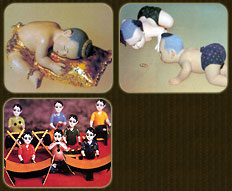
Her Majesty the Queen promoted traditional handicrafts and skilled workmanship across all regions, taking into account the local customs, traditions, culture, and available materials.
In the central region, for example, materials such as narai fiber, mats, and fishing nets were used to weave bags, hats, shoes, plate mats, and other items. Teachers were also sent to train villagers in cotton weaving, and there was a project to craft Thai dolls.
The Thai doll project not only provided an additional source of income for the people but also helped preserve Thai art and culture. These dolls, crafted to reflect traditional gestures, attire, daily life, and customs, became a way to promote Thai culture internationally.
In the northern region, Her Majesty the Queen initiated projects for silk weaving, brocade, patterned woven fabrics, and thick cotton textiles, along with embroidery, sewing crafts, coat hangers, and hill-tribe silver ornaments used as jewelry.
During Her Majesty’s royal visits with His Majesty the King to the Thai hill tribes, she observed that the Yao people had garments richly embroidered with intricate patterns and vibrant colors—a traditional art passed down through generations. She therefore promoted and supported Yao embroidery to ensure that this cultural heritage would not be lost.
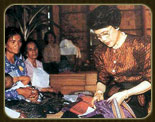
In the Northeastern region, villagers traditionally wove mudmee (ikat) and silk fabrics for personal use but faced a shortage of silk for weaving. Her Majesty the Queen supported the rearing of native silk worms and the weaving of mudmee silk skirts, using traditional patterns. She personally provided funds for materials and labor, and purchased the fabrics woven by the villagers. Additionally, weavers with exceptional skill received special royal awards in addition to their wages.
In the Southern region, there was originally weaving of distinctive local fabrics, such as floral patterns (pikoon flowers), royal patterns, and jasmine motifs. Later, weaving declined due to limited popularity. Her Majesty the Queen revived local weaving to increase its appeal. She also initiated projects to craft flowers from cotton scraps, silk, and other fabrics, and promoted various southern handicrafts, such as weaving sedge mats and creating items from rattan vines (yanli-poa) commonly found in the South, which were made into practical objects like bags, trays, platters, and coasters.

Yanli-poa vine

Yanli-poa bag
In addition to the general local Handicrafts Promotion Projects, Her Majesty the Queen also initiated the establishment of a Special Handicrafts Center to train farmers in the land reform area of Bang Sai District, Phra Nakhon Si Ayutthaya Province. The center covers approximately 700 rai and provides training in various handicraft skills suited to the local environment, available materials, and the abilities of the farmers. Some crafts are traditional to the local area, while others are adapted from other regions. This vocational training center has been in operation since 1981 (B.E. 2524).

These handicraft activities have now expanded widely across nearly every province of Thailand. As a result, farming families and underprivileged households—especially those with hidden unemployment—have been able to earn additional income to support their families and improve their well-being to some extent. The quantity and quality of their handicraft production have steadily increased, gaining recognition and appreciation both domestically and internationally.
Beyond the economic benefits, these projects have also helped preserve Thailand’s unique traditional arts and culture, preventing them from being lost.
These royal initiatives clearly demonstrate Her Majesty the Queen’s exceptional wisdom and diligence. She has been able to carry out projects in a way that harmoniously supports the work and royal duties of His Majesty the King, ultimately contributing to the prosperity, happiness, and well-being of the Thai people and the nation as a whole.

